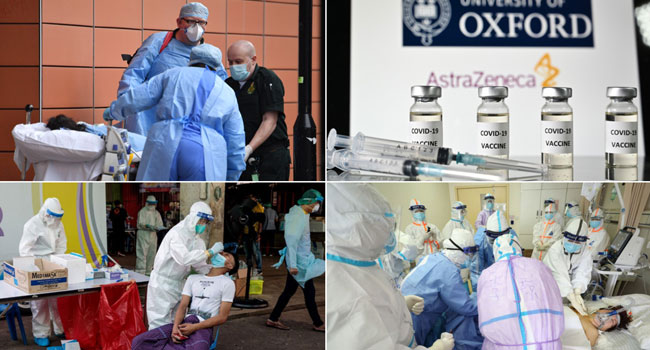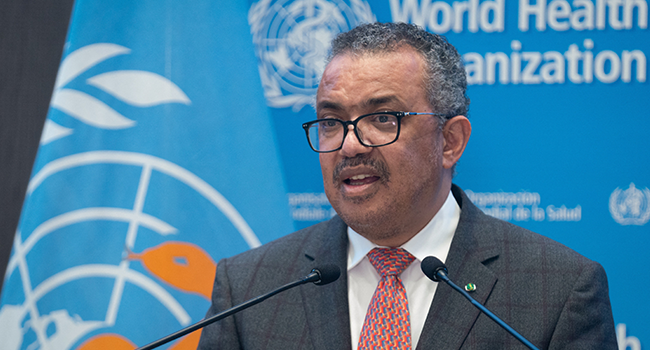From the first cases in central China to vaccinations being rolled out a year later, here are a dozen key developments in the spread and subsequent fight against Covid-19.
– First death –
On December 31, 2019, the World Health Organization (WHO) is alerted to a cluster of pneumonia cases “of unknown cause” in the central Chinese city of Wuhan.
A week later, a new coronavirus is identified. China confirms on January 11 its first death in Wuhan from an illness which will be named Covid-19.
– Wuhan cut off –
On January 23, Wuhan is placed under quarantine and cut off from the world. Countries start to repatriate their citizens from China.
On February 15, France reports the first death confirmed outside Asia, a Chinese tourist.
– ‘Pandemic’ –
By March 6, more than 100,000 cases have been recorded around the world.
Northern Italy is locked down, quickly followed by the rest of the country.
On March 11, the WHO says Covid-19 is a pandemic.
Global stock markets crash.
Governments and central banks roll out massive economic support measures.
– Europe in lockdown –
Spain (March 14) and France (March 17) order their populations to stay at home. Germany and Britain say people should avoid all social contact. The 27-nation European Union closes its external borders.
– Olympics postponed –
On March 24, the Tokyo summer Olympics scheduled for July 2020 are put off to the next year.
The following day, the United Nations warns that the pandemic is “threatening the whole of humanity”.
– Half of the world confined –
Lockdown measures are enforced all around the world.
On April 2, more than 3.9 billion people — half of the world’s population — are forced or called on to confine themselves, according to an AFP count. The same day the threshold of one million cases is crossed.
British Prime Minister Boris Johnson is infected and ends up in intensive care.
– Economy on its knees –
On April 29, the battered US aircraft manufacturer Boeing slashes 16,000 jobs.
Many other airlines and car manufacturers follow.
– Hydroxychloroquine row –
Backed by US President Donald Trump as a potential treatment for Covid-19, malaria drug hydroxychloroquine is judged to have no benefit at all, according to British scientists on June 5.
– Surge in Latin America –
By June 7, the global death toll reaches more than 400,000.
The surge of cases and deaths in Latin America causes concern.
Brazil becomes the country with the second biggest death toll after the US. Its president Jair Bolsonaro calls it a “little flu”, before himself becoming infected. Fellow Covid-19 sceptic Donald Trump will also get it.
– Masks and anti-masks –
With cases on the increase, several European countries make mask wearing compulsory on public transport, in schools and shops and on the street.
Anti-mask demonstrations are organised in London, Paris and Rome, with protesters attempting to storm the Reichstag building in Berlin on August 30.
– More waves, new variants –
The grim milestone of a million deaths worldwide is passed on September 28. In October, infections start to spiral in Europe, where many countries order new lockdowns and curfews.
The pandemic also picks up pace in the US, where its handling is a key issue in the presidential campaign.
A new US deaths record is reached on January 8, 2021, with just short of 4,000 fatalities in 24 hours.
The emergence in England of a more contagious variant — first detected in the country in September — forces British Prime Minister Boris Johnson on January 4 to announce a new lockdown for England and Scotland.
The variant is detected in several other countries and the rest of Europe tightens restrictions.
Other highly-contagious strains are also detected in South Africa and Brazil.
On January 7, the WHO calls the surging cases and new variants “alarming… and a tipping-point in the course of the pandemic.”
– Vaccines kick in –
On November 9, US biotech giant Pfizer and its German partner BioNTech say they have a highly successful vaccine, as the number of official cases passes 50 million.
A week later, a similar announcement comes from US firm Moderna, with an AstraZeneca-Oxford University vaccine following fast behind.
Britain is the first Western nation to start vaccinating, with rollout in the rest of Europe uneven, causing widespread frustration.
In January, India also approves a vaccine from a domestic drugmaker Bharat Biotech.
Meanwhile, China’s Sinovac and Sinopharm vaccines and Russia’s Sputnik V jab have been rolled out in both countries and beyond for months, although none has yet to be fully approved by either Beijing or Moscow’s health authorities.





